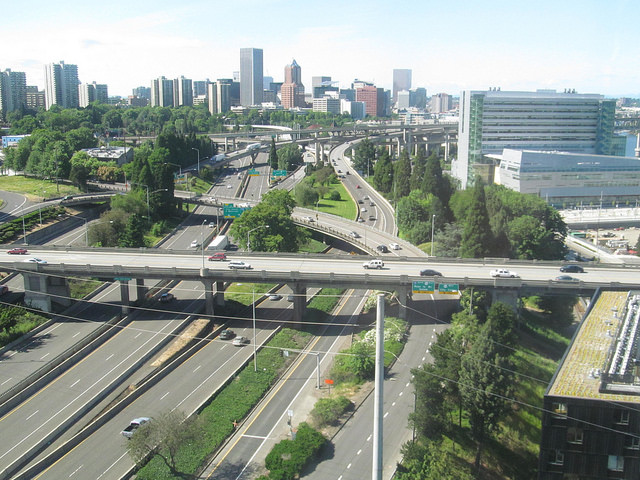While headlines focus on the nearly-bankrupt federal Highway Trust Fund, state and local departments of transportation across the country are facing declining revenues, maintenance backlogs, and an insatiable desire for funding new projects. As a result, this summer, a number of states are working on new highway funding packages. So far in 2015, eight states have enacted revenue increases, but others are still struggling to do so. Michigan’s Legislature is contemplating a $3.4 billion plan that would be financed in part by cutting the state’s earned income tax credit. Minnesota couldn’t muster the support for a proposed $6 billion statewide program, settling instead for a “lights on” alternative that actually reduces statewide highway construction funds by about one-sixth.

And this past week, Oregon’s effort to fund a new transportation package imploded, after carbon reduction estimates prepared by the State Department of Transportation were shown to be exaggerated by a factor of five.
The Oregon Legislature was considering a $343 million program financed by a higher gas tax and vehicle registration fees—but a critical element in the compromise to get the needed support for the bill was a repeal of the state’s recently enacted “clean fuels” law, which would have required lower carbon content in the state’s fuels.
Advocates of the repeal (and the transportation package) had argued that provisions in the new program—including a series of investments in alternative fuel vehicles and electric vehicle charging stations, coupled with “operational improvements” in state highways—would reduce carbon emissions by as much as the clean fuels law. According to the state transportation department, measures like additional ramp meters, variable electronic speed limit signs, and travel advisory signs would lower carbon emissions.
But in dramatic testimony to the State Legislature on June 24, Oregon Department of Transportation (ODOT) Director Matt Garrett conceded that his staff had overstated carbon emissions savings by a factor of five, and that rather than saving more than 2 million tons of carbon over a decade, the measures would save only about 400,000 tons. This admission vindicated the opposition of environmental groups, and led Governor Kate Brown and legislative leaders to withdraw support for the bill.
It’s striking that environmental considerations played such a key role in the defeat of this transportation measure. There’s little question that carbon emissions from transportation are a major contributor to greenhouse gases and climate change, but policymakers in very few states have made the connection between added road building and more carbon pollution.
A critical question is whether operational improvements like ramp metering actually reduce emissions. Data cited by Oregon environmental groups cast serious doubt on that assertion. The Oregon Environmental Council produced a Federal Highway Administration report showing the evidence that transportation operations improvements reduce greenhouse gases is “largely inconclusive.” Yes, some measures may smooth out traffic flow, thereby reducing emissions, but they also lead to additional ramp idling. What’s more, cars consume more gas per mile at higher speeds than lower ones. Some studies find that such projects actually increase net emissions.
As environmental groups like the Oregon Environmental Council and the Oregon League of Conservation Voters pointed out, even ODOT’s new, much-reduced estimate of carbon savings are extremely suspect.
The Federal Highway Administration commissioned the RAND Corporation to study the scientific literature on the efficacy of alternative investments—including ramp metering—in reducing greenhouse gas emissions. RAND’s 2012 review concluded that studies of the impact of “operations improvements” on vehicle emissions have produced mixed results, to say the least.
For example, according to RAND, one of the few evaluations of the effect of ramp metering on emissions was carried out in Oregon. The state deployed 16 ramp meters on a stretch of I-5 in and around downtown Portland in the AM and PM peaks, and estimated that overall, emissions fell by 1,000 tons per year. This implied that per meter savings (on this very heavily used stretch of urban freeway, with 1980s vintage gas guzzlers,) saved about 64 tons per meter per year. If you could duplicate that record (with today’s much more fuel efficient cars, and on roads with much lighter traffic), it would require metering 640 freeway ramps to achieve 400,000 tons of savings per year.
As it turns out, there aren’t anywhere near that many freeway ramps in the entire state. What’s more, ramp metering has already been installed on all of the most heavily traveled freeways in the Portland area, meaning that the segments that are left are likely to be much less “productive” in terms of carbon reductions.
But that’s just the visible tip of a much larger carbon emissions iceberg that this package represented. The $343 million bill earmarked $124 million dollars for a series of highway expansion projects, including widening the I-205 Freeway from 4 to 6 lanes in Portland’s suburbs. The scientific evidence on the effect of capacity increases on carbon emissions is unequivocal: providing more capacity generates “induced demand”—more traffic, longer trips, and greater sprawl—and therefore actually increases carbon emissions. As far as we can tell, ODOT’s modeling of HB 2801 made no allowance for the increased carbon emissions as a result of induced demand.
But here, the science is well established. One need go no further than Portland State University’s Transportation Research and Education Center. Two of its scientists, Alex Bigazzi and Miguel Figliozzi, in a paper published by the Transportation Research Board, showed that increasing capacity on congested roads to allow traffic to move faster and more smoothly actually increases total emissions.
As a society, we’re increasingly coming to understand that the threat of climate change is real, and we are also beginning to understand that it will necessitate a different approach to transportation investments than we’ve made in the past. It’s tempting—but simply wrong—to think that making cars move faster is a solution. This clash in Oregon is a harbinger that efforts to combat climate change and business-as-usual transportation spending are likely to be on a collision course in the years ahead.
